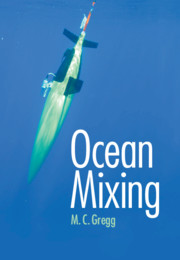Book contents
- Frontmatter
- Dedication
- Contents
- Preface
- 1 Mixing and Its Role in the Ocean
- 2 Thermodynamics and Seawater Properties
- 3 Turbulence
- 4 Double Diffusion
- 5 Sampling Mixing and Its Environment
- 6 Internal Waves and the Vortical Mode
- 7 Interactions and Dissipation of Internal Waves and the Vortical Mode
- 8 Mixing in the Stratified Interior
- Appendix A Mixing in the Stratified Interior
- Appendix B The GM79 Internal Wave Spectrum, Prepared with R.-C. Lien
- Bibliography
- Index
- Color Plates
5 - Sampling Mixing and Its Environment
Published online by Cambridge University Press: 10 March 2021
- Frontmatter
- Dedication
- Contents
- Preface
- 1 Mixing and Its Role in the Ocean
- 2 Thermodynamics and Seawater Properties
- 3 Turbulence
- 4 Double Diffusion
- 5 Sampling Mixing and Its Environment
- 6 Internal Waves and the Vortical Mode
- 7 Interactions and Dissipation of Internal Waves and the Vortical Mode
- 8 Mixing in the Stratified Interior
- Appendix A Mixing in the Stratified Interior
- Appendix B The GM79 Internal Wave Spectrum, Prepared with R.-C. Lien
- Bibliography
- Index
- Color Plates
Summary
This chapter explores how mixing is measured, focusing on what can be measured and how accurately. It begins with probes measuring dissipation scales, i.e. thermistors and airfoils, but also includes other devices not used routinely, such as pitot tubes. Finescale sensors are also examined, with an emphasis on absolute accuracy and salinity spiking. Then the vehicles carrying the probes are described, i.e. profilers, tows, AUVs, and submersibles. Moorings and fixed platforms are also briefly examined. Finally, remote sensing, principally using backscatter from high-frequency acoustics, is reviewed, along with tracer releases for measuring net diffusivity.
Keywords
- Type
- Chapter
- Information
- Ocean Mixing , pp. 156 - 196Publisher: Cambridge University PressPrint publication year: 2021

